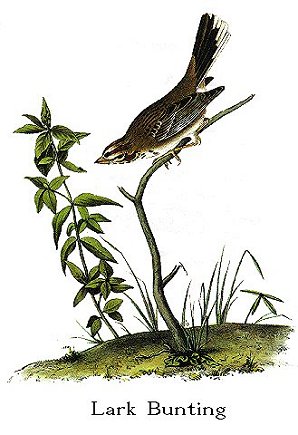
| Family XV. FRINGILLINAE. FINCHES. GENUS II. EMBERIZA, Linn. BUNTING. |
Next >> |

Family |
LARK BUNTING. [Lark Sparrow.] |
| Genus | EMBERIZA GRAMMACA, Say. [Chondestes grammacus.] |
This beautiful species is another of those of which we owe our first
knowledge to Colonel LONG's party, who discovered it on their expedition to the
Rocky Mountains. To the Prince of MUSIGNANO we are indebted for the first
figure of it. That naturalist states, in the short account he has given of it,
that "it sings sweetly, and often continues its notes while on the wing," and to
this I can only add the following statement with which I am favoured by my
friend Mr. NUTTALL.
"This species, in small flocks, in the spring season, when we saw it,
appears rather frequent on the ground, resting on it in silence, or merely
uttering a feeble chirp. They do not appear on the central table-land, or on
the western plains. We therefore had no opportunity of learning any thing of
their habits in the breeding season. I believe they are occasionally seen at no
great distance from the upper settlements of the Missouri."
Upper Missouri, and eastern declivities of the Rocky Mountains. Common.
Migratory.
FRINGILLA GRAMMACA, Bonap. Amer. Orn., vol. i. p. 47.
LARK FINCH, Nutt. Man., vol. i. p. 480.
LARK FINCH, Fringilla grammaca, Aud. Orn. Biog., vol. v. p. 17.
Adult Male.
Bill short, stout, conical, compressed toward the end; upper mandible with
the dorsal line very slightly convex, the ridge extending but a short way on the
forehead, where it tapers to a point, the sides rounded, the edges direct and
overlapping, the tip pointed, the gape-line nearly straight, a little deflected
at the base; lower mandible of the same breadth as the upper, with the angle
very short and broad, the dorsal line ascending and straight, the back broad,
the sides rounded, the edges inflected, the tip acute. Nostrils basal, small,
roundish, concealed by the feathers.
Head of moderate size, ovate; neck short, body full. Feet of moderate
length and rather slender; tarsus rather short, compressed, anteriorly covered
with seven scutella posteriorly with two longitudinal plates meeting so as to
form a very sharp edge; toes moderate, the first strong, the lateral equal;
claws rather long, slender, much compressed, laterally grooved, moderately
arched, very acute.
Plumage soft and blended, the feathers ovate. There are short bristles at
the base of the upper mandible. Wings of moderate length; the outer three
quills nearly equal, the third longest, but exceeding the first only by
one-twelfth of an inch, and the second by a quarter of a twelfth; the fourth not
much shorter, the rest slowly decreasing; the outer secondaries emarginate, the
inner tapering to a blunt point, one of them considerably elongated. Tail
rather long, rounded.
Bill reddish flesh-colour, the upper mandible tinged with dusky. Feet and
claws flesh-colour. On the upper part of the head are three longitudinal bands
of white, separated by two of light red, the anterior part of which is black.
The upper parts are light greyish-brown, longitudinally streaked with dusky, the
central part of each feather being of the latter colour, the hind part of the
back and the rump without streaks. On the wing are two faint bands of
yellowish-white, formed by the tips of the first row of small coverts, and those
of the primary coverts, and a patch of the same formed by the bases of the outer
primaries; the quills dusky brown, slightly margined with whitish, the inner
secondaries with light red; the tail darker, all the feathers excepting the
middle terminated by white, which on the outer occupies more than a third of its
length, and extends nearly to the base of the outer web. Below the eye is a
white streak; the cheeks are light red, with an anterior black spot; under them
a broad white band extends from the lower mandible and curves upwards,
separated from the throat, which is white, by a short line of black on each
side. The lower parts are yellowish-white, the lower part of the neck greyish,
the sides tinged with greyish-brown, the lower wing-coverts greyish-white.
Length to end of tail 6 1/2 inches; extent of wings 8 1/4; bill along the
ridge (6 1/4)/12, along the edge of lower mandible 7/12; wing from flexure
3 8/12; tail 3; tarsus /12; hind toe (4 1/4)/12, its claw (3 1/2)/12; middle
toe (7 1/2)/12, its claw 3/12.
| Next >> |